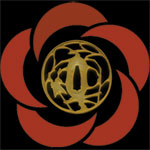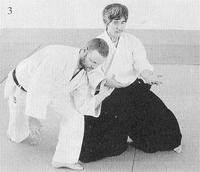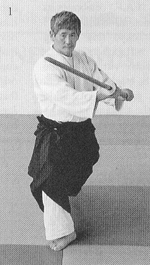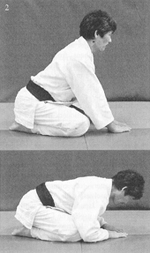 |
London, 3 May 2000, about Sensei's on-going study of Aikidoby Peter Megann, B.A.F. General Secretary// Источник: B.A.F. Newsletter, Июль 2000, No 36
Visiting Kanetsuka Sensei in his new home in North Finchley, London, in May, Peter Megann took the opportunity to chat about Sensei's on-going study of Aikido. P.M.: I've been a student of yours, Sensei, for over 25 year and have tried hard to keep up with the development of your Aikido: but somtimes I feel I'm being left far behind! K.S.: Well, you know, all the textbooks on Aikido say there should be no pushing and no pulling; no striking, no kicking, etc. P.M.: So first comes protection, and after that comes control? K.S.: Yes; how I can lead my partner and make him follow me naturally and smoothly - without forcing? This is the problem that has concerned me most. I think the key lies in the hai-shin- undo (backstretch) exercise; how we control our partner either to the front or to the rear. If we can do this simple exercise properly, we can adapt it to techniques. And we must be able to control and lead our partner even when we are not actually grippng: we should be able to do this even though we have no fingers.
Most impotent is to start with correct, stable posture This is very much like the kamae called kurau-dachi in some traditional sword schools like Kashima-ryu. You maintain zen-kutsu, that's to say with your weight mainly on your front foot, your front knee well bent. Arms are not bent; yet not straight. The elbows just a little bit down; that's all The posture is basically triangular: pyramid-shape, the top narrow, the base wide. In Aikido this is at the moment of kime or contact with your partner. Then we must shift our centre of gravity, as in the tori- fune exercise; from the front to the back foot, or from the back to the front foot. If you are holding a sword, your sword makes contact with your partner's sword or neck; but in Aikido, without a sword, the contact is closer: with just one step - irimi or tenkan, as the case may be - you make contact with your partner's neck or armpit. We talk about the three shapes that represent Aikido movement: the cicle, th triangle and the square. But these are not just two-dimensional. The circle is also the sphere; the triangle the pyramid; and the square is the cube, which I understand as representing solidity. And that's what I like about the kurai-dachi stance. Also the kurai-dachi kamae is suitable both for defence and attack. In your Aikido stance there should be the same feeling: no shrinking between you and your partner. You should maintain your own sphere, your own world, your own property, so to speak. P.M.: I've noticed that over the past twelve months and so, when it's been possible at courses you've conducted, you've had the students practice against a wall. Why is that? K.S.: I got the idea from sumo. A sumo dojo is very small. Actually it's been said that in Aikido half a tatami is enough for practice. So going back to the idea of the sphere, we should be inside our own capsule or womb. Imagine twin babies inside a womb. They have to manage in that very restricted space for nine months! Or astronauts inside a space capsule. So if we practice with our backs against a wall, there's no escape. The wall places a restriction on our movements: it disciplines us to defend ourselves with minimum movement. I also think about a wave crashing against a rock. Its energy is diverted upwards and backwards. Our partner's momentum must be diverted like this. We do this through our own kukyu power based on a stable posture, and lowering our centre of gravity with good balance and timing. It's useful, too, to practise facing a wall to develop our kokyu. When we face a wall in hanmi posture, as we bend our front knee and move our centre forwards our hands must not strike the wall. Instead, our arms must rise, elbows coming up and outwards, as in furi-kaburi (defending the head) in sword-work. In all this we must have a humble mind; we must not be proud. Your mind and body down to earth: down, down. Instead of pushing, you go down; and with your whole body, not just your hand. However, you must be very positive, not negative; even when you make tenkan to receive your partner's force. This is all very difficult to explain or show.
P.M.: So you have your tanden engaged all the time? K.S.: That's right. But when we say tanden, we must understand that tanden is between your back and your partner. Not just your belly pushed forwards. The energy is flowing from your back foot to your front foot; and between those points is your tanden. Your arms must rise naturally. It's just like making za-rei (sitting bow). When you bow your elbows bend as you incline our body towards the ground and your head comes down towards your hands that are placed on the ground. It's very much like this movement in reverse, if you understand what I mean, when we raise our arms in say shiho-nage or ikkyo. Our elbows bend and rise naturally as our hands reach the height of our forehead. It's like an umbrella opening. At the same time your body goes down and you change direction as necessary. In this way you lead your partner, and though very positive you are not pulling or pushing. The movement of the arms reminds me of the breaststroke in swimming, how they come to the centre then spread out and open. So; if Aikido is the Way of Aiki, there is no graduation. No diploma at the end of the course. It's like our life also: graduation means death! In Aikido we never reach final stage; we must keep studying and studying, developing and developing. I love Aikido and even small things give me pleasure. I like to watch either beginners or seniors and observe how they understand, how they develop. It makes me very happy. |
||||||
| © Рюсинкан.ру |



